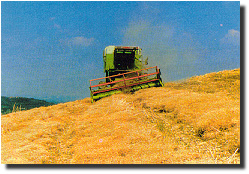
CROPLAND LOSSES THREATEN WORLD FOOD SUPPLIESBecause grain production has not kept up with food demand, the world has consumed half its grain reserves since 1987, dropping them to the lowest level on record. Yet government leaders in nearly every country allow land that could produce grain to be paved over or degraded by erosion. In this new Worldwatch Paper, Shrinking Fields: Cropland Loss in a World of Eight Billion, Research Associate Gary Gardner reports that the area of grainland supporting each person has fallen to less than one sixth the size of a soccer field -- yet most governments make little effort to preserve this basic agricultural resource. "In effect," Gardner said, "policymakers are gambling that increases in grain yields equal to the dramatic gains of the last generation will continue indefinitely. But with a decade of faltering yields behind us, this is risky policy." With grain reserves now at an all time low of 48 days of consumption -- barely pipeline supplies -- Shrinking Fields argues that if we fail to halt heavy losses of cropland, it is unlikely that we will be able to feed a world population that will increase by more than 400 million people in just five years. Cropland losses are occurring on every continent, including these examples:
The three principal sources of grainland loss are:
"Replacing lost land is likely to be more difficult than many officials think," Gardner said. "Optimistic officials often overestimate the potential for expansion by including marginal land, where cultivation may not be sustainable. Indeed, the world's major grain producers have all overexpanded into marginal land in recent years, damaging large areas of land in the process. Many are now pulling back to the land that can be cultivated, with a resulting loss of grain production." The shrinking supply of quality cropland and lethargic growth in yields comes on the brink of the largest projected increase in food demand in history. In 25 years, farmers will be asked to feed 7.9 billion people -- 2.2 billion more than they do today. Nine out of ten new births will occur in developing countries, where grain self-sufficiency has fallen from 96 percent in 1969/71 to 88 percent in 1993/95. In addition, economic expansion is allowing hundreds of millions to move from a monotonous starchy diet to meals that include meat, fruits and vegetables, and vegetable oil. While these foods offer benefits to consumers and farmers, they also require more land to produce. There is little room for large-scale expansion of grainland, and a large increase in food demand is just around the corner. Although yields could conceivably regain their robust growth of past decades, banking on such gains is risky. Key contributions to the earlier surge in yields, such as expanding irrigation, are no longer available on the same scale, or they may be environmentally or socially unacceptable, such as increased use of pesticides. If that is the case, continued tolerance of unjustified losses of cropland will increase the pressure on yields, and with it, the risk of supply failures. If policymakers do not see cropland as a key strategic resource -- no less important than oil reserves or armed forces -- then they will not take steps to halt these losses or protect the quality of remaining farmland. Yet preservation programs in Europe and in the United States have saved millions of hectares of prime farmland from the bulldozer. And proven technologies for reducing erosion on all kinds of agricultural fields can be more widely implemented. In addition, increased funding for technologies to make agriculture more sustainable -- as well as productive -- can help reduce the pressures on remaining agricultural land. The author concludes, "But the challenge is pressing. By 2020, if current trends continue, each of the world's people will rely on an average of just one eighth of a soccer field to meet his or her grain needs. Despite the past successes in raising land productivity, this small area leaves no room for error. If we do not preserve our farmland, the next generation could pay for the cropland we lose with higher food prices or hunger." Fonte: Worldwatch Institute
|